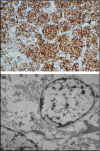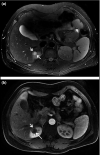Preoperative Diagnosis of Juxtaglomerular Cell Tumors in Eight Patients
- PMID: 27012170
- PMCID: PMC8031485
- DOI: 10.1111/jch.12810
Preoperative Diagnosis of Juxtaglomerular Cell Tumors in Eight Patients
Abstract
The aim of this study was to improve the diagnostic efficiency for juxtaglomerular cell tumors (JCTs) and to determine whether clinical and magnetic resonance imaging features can help to differentiate JCTs from clear cell renal cell carcinoma (ccRCC). The clinical features of eight patients with JCTs and 27 patients with ccRCCs were analyzed. A flow diagram for young people with hypertension was applied to facilitate the diagnosis. Clinical presentations were analyzed, including age, hypertension, and hypokalemia. The results of our study produced a flow diagram that narrowed the scope of diagnosis. The statistical results demonstrated that patients with a renal mass aged 14 to 30 years, had grade 3 hypertension, or had moderate hypokalemia had a greater possibility of having a JCT than a ccRCC (P<.0000, P<.01, P<.0005, respectively). In addition, the flow diagram and magnetic resonance imaging features were useful to distinguish JCTs from other renal tumors.
©2016 Wiley Periodicals, Inc.
Figures



Similar articles
-
Usefulness of Magnetic Resonance Imaging in the Diagnosis of Juxtaglomerular Cell Tumors: A Report of 10 Cases and Review of the Literature.Am J Kidney Dis. 2019 Apr;73(4):566-571. doi: 10.1053/j.ajkd.2018.09.005. Epub 2018 Dec 4. Am J Kidney Dis. 2019. PMID: 30527885 Review.
-
Juxtaglomerular cell tumor of the kidney: case report and differential diagnosis with emphasis on pathologic and cytopathologic features.Int J Surg Pathol. 2011 Feb;19(1):93-8. doi: 10.1177/1066896908329413. Epub 2008 Dec 18. Int J Surg Pathol. 2011. PMID: 19098017
-
Juxtaglomerular cell tumor of the kidney--a new classification scheme.Urol Oncol. 2010 Jan-Feb;28(1):34-8. doi: 10.1016/j.urolonc.2009.08.003. Epub 2009 Nov 13. Urol Oncol. 2010. PMID: 19914097 Review.
-
Ward round--A rare tumor of the kidney resulting in hypertension, renal failure and a cerebrovascular accident in a young female.Malawi Med J. 2011 Mar;23(1):18-9. doi: 10.4314/mmj.v23i1.67677. Malawi Med J. 2011. PMID: 23638251 Free PMC article.
-
Juxtaglomerular Cell Tumor: A Rare, Curable Cause of Hypertension in a Young Patient.Urology. 2019 Dec;134:42-44. doi: 10.1016/j.urology.2019.06.009. Epub 2019 Jun 21. Urology. 2019. PMID: 31233811 No abstract available.
Cited by
-
Renovascular hypertension following by juxtaglomerular cell tumor: a challenging case with 12-year history of resistant hypertension and hypokalemia.BMC Endocr Disord. 2024 Nov 14;24(1):244. doi: 10.1186/s12902-024-01770-7. BMC Endocr Disord. 2024. PMID: 39543528 Free PMC article.
-
Case report: a nonfunctioning juxtaglomerular cell tumor mimicking renal cell carcinoma.Medicine (Baltimore). 2020 Sep 4;99(36):e22057. doi: 10.1097/MD.0000000000022057. Medicine (Baltimore). 2020. PMID: 32899070 Free PMC article.
-
Minimally Invasive Surgery-Based Multidisciplinary Clinical Management of Reninoma: A Single-Center Study.Med Sci Monit. 2019 Mar 1;25:1600-1610. doi: 10.12659/MSM.913826. Med Sci Monit. 2019. PMID: 30822300 Free PMC article.
-
Pregnancy complicated by juxtaglomerular cell tumor of the kidney: A case report.World J Clin Cases. 2023 Apr 16;11(11):2541-2548. doi: 10.12998/wjcc.v11.i11.2541. World J Clin Cases. 2023. PMID: 37123308 Free PMC article.
References
-
- Robertson PW, Klidjian A, Harding LK, et al. Hypertension due to a renin‐secreting renal tumour. Am J Med. 1967;43:963–976. - PubMed
-
- Ørjavik OS, Fauchald P, Hovig T, et al. Renin‐secreting renal tumour with severe hypertension. Case report with tumour renin analysis, histopathological and ultrastructural studies. Acta Med Scand. 1975;197:329–335. - PubMed
-
- Conn JW, Cohen EL, McDonald WJ, et al. Hypertension, hyperreninemia and secondary aldosteronism due to rennin producing juxtaglomerular cell tumor. Arch Intern Med. 1972;13:682–696. - PubMed
-
- McVicar M, Carman C, Chandra M, et al. Hypertension secondary to renin‐secreting juxtaglomerular cell tumor: case report and review of 38 cases. Pediatr Nephrol. 1993;7:404–412. - PubMed
-
- Osawa S, Hosokawa Y, Soda T, et al. Juxtaglomerular cell tumor that was preoperatively diagnosed using selective renal venous sampling. Intern Med. 2013;52:1937–1942. - PubMed
MeSH terms
LinkOut - more resources
Full Text Sources
Other Literature Sources
Medical

